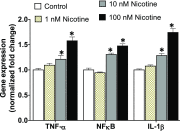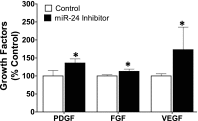Nicotine Modulates Growth Factors and MicroRNA to Promote Inflammatory and Fibrotic Processes
- PMID: 30446578
- PMCID: PMC6323623
- DOI: 10.1124/jpet.118.252650
Nicotine Modulates Growth Factors and MicroRNA to Promote Inflammatory and Fibrotic Processes
Abstract
Idiopathic pulmonary fibrosis (IPF) is a fatal disease that destroys the structure and function of the lungs. Risk factors include advanced age and genetic predisposition. However, tobacco use is the chief modifiable risk factor. The prevalence of tobacco use in IPF reaches up to 80%. Although tobacco smoke contains over 5000 chemicals, nicotine is a major component. Nicotine is a bioactive molecule that acts upon nicotinic acetylcholine receptors expressed on neuronal and non-neuronal cells including endothelial cells. Accordingly, it has a pleiotropic effect on cell proliferation and angiogenesis. The angiogenic effect is partly mediated by stimulation of growth factors including fibroblast, platelet-derived, and vascular endothelial growth factors. Nintedanib, a Food and Drug Administration-approved drug for IPF, works by inhibiting receptors for these growth factors, suggesting a pathobiologic role of the growth factors in IPF and a potential mechanism by which tobacco use may exacerbate the disease process; additionally, nicotine downregulates anti-inflammatory microRNAs (miRs) in lung cells. Here, we profiled the expression of miRs in lung tissues explanted from a lung injury model and examined the effect of nicotine on one of the identified miRs (miR-24) and its downstream targets. Our data show that miR-24 is downregulated during lung injury and is suppressed by nicotine. We also found that nicotine upregulates the expression of inflammatory cytokines targeted by miR-24. Finally, nicotine stimulated growth factors, fibroblast proliferation, collagen release, and expression of myofibroblast markers. Taken together, nicotine, alone or as a component of tobacco smoke, may accelerate the disease process in IPF through stimulation of growth factors and downregulation of anti-inflammatory miRs.
Copyright © 2019 by The American Society for Pharmacology and Experimental Therapeutics.
Figures












Similar articles
-
Nicotine upregulates FGFR3 and RB1 expression and promotes non-small cell lung cancer cell proliferation and epithelial-to-mesenchymal transition via downregulation of miR-99b and miR-192.Biomed Pharmacother. 2018 May;101:656-662. doi: 10.1016/j.biopha.2018.02.113. Epub 2018 Mar 22. Biomed Pharmacother. 2018. PMID: 29518612
-
TGF-β1-induced miR-424 promotes pulmonary myofibroblast differentiation by targeting Slit2 protein expression.Biochem Pharmacol. 2020 Oct;180:114172. doi: 10.1016/j.bcp.2020.114172. Epub 2020 Jul 24. Biochem Pharmacol. 2020. PMID: 32712053 Free PMC article.
-
Mesenchymal stem cells-derived exosomes carrying microRNA-30b confer protection against pulmonary fibrosis by downregulating Runx1 via Spred2.Mol Genet Genomics. 2024 Mar 13;299(1):33. doi: 10.1007/s00438-024-02116-7. Mol Genet Genomics. 2024. PMID: 38478174
-
MicroRNAs in idiopathic pulmonary fibrosis.Transl Res. 2011 Apr;157(4):191-9. doi: 10.1016/j.trsl.2011.01.012. Epub 2011 Feb 4. Transl Res. 2011. PMID: 21420029 Review.
-
Angiogenic activity of nicotinic acetylcholine receptors: implications in tobacco-related vascular diseases.Pharmacol Ther. 2009 Feb;121(2):205-23. doi: 10.1016/j.pharmthera.2008.10.007. Epub 2008 Nov 14. Pharmacol Ther. 2009. PMID: 19063919 Review.
Cited by
-
MiR-199a-3p/5p participated in TGF-β and EGF induced EMT by targeting DUSP5/MAP3K11 in pterygium.J Transl Med. 2020 Sep 1;18(1):332. doi: 10.1186/s12967-020-02499-2. J Transl Med. 2020. PMID: 32867783 Free PMC article.
-
Angiotensin II Type I Receptor Antagonism Attenuates Nicotine-Induced Cardiac Remodeling, Dysfunction, and Aggravation of Myocardial Ischemia-Reperfusion Injury in Rats.Front Pharmacol. 2019 Dec 12;10:1493. doi: 10.3389/fphar.2019.01493. eCollection 2019. Front Pharmacol. 2019. PMID: 31920673 Free PMC article.
-
The Smoking Paradox in Stroke Patients Under Reperfusion Treatment Is Associated With Endothelial Dysfunction.Front Neurol. 2022 Mar 24;13:841484. doi: 10.3389/fneur.2022.841484. eCollection 2022. Front Neurol. 2022. PMID: 35401421 Free PMC article.
-
Early Life Exposure to Nicotine: Postnatal Metabolic, Neurobehavioral and Respiratory Outcomes and the Development of Childhood Cancers.Toxicol Sci. 2020 Nov 1;178(1):3-15. doi: 10.1093/toxsci/kfaa127. Toxicol Sci. 2020. PMID: 32766841 Free PMC article. Review.
-
Dysregulated repair and inflammatory responses by e-cigarette-derived inhaled nicotine and humectant propylene glycol in a sex-dependent manner in mouse lung.FASEB Bioadv. 2019 Oct;1(10):609-623. doi: 10.1096/fba.2019-00048. Epub 2019 Aug 23. FASEB Bioadv. 2019. PMID: 31825014 Free PMC article.
References
-
- Atamas SP. (2017) Vascular endothelial growth factor in idiopathic pulmonary fibrosis. An imbalancing act. Am J Respir Crit Care Med 196:409–411. - PubMed
Publication types
MeSH terms
Substances
Grants and funding
LinkOut - more resources
Full Text Sources
Medical

